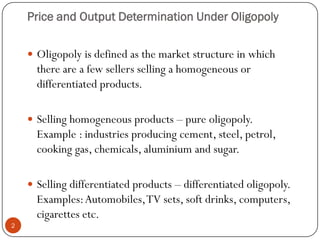Oligopoly is a market structure in which a small number of firms dominate the industry. In this type of market, firms are interdependent, meaning that the actions of one firm will affect the others. This is because the actions of one firm can alter the market conditions, and therefore the profits of the other firms. As a result, firms in an oligopoly must consider the reactions of their competitors when making pricing and output decisions.
One way in which firms in an oligopoly may determine price and output is through collusion, which is when firms agree to act together in order to increase profits. This can take the form of price fixing, where firms agree to charge a certain price for their products, or output restriction, where firms agree to limit the amount of goods they produce in order to drive up prices. While collusion is illegal in most countries, it can be difficult to detect and enforce.
Another way in which firms in an oligopoly may determine price and output is through a process called strategic pricing. In this approach, firms take into account the expected reactions of their competitors when setting prices and production levels. For example, if a firm expects its competitors to lower their prices in response to a price increase, it may decide to not raise its prices in order to avoid losing market share. Alternatively, if a firm expects its competitors to raise their prices in response to a price decrease, it may decide to lower its prices in order to increase its market share.
In addition to considering the actions of their competitors, firms in an oligopoly may also consider the demand for their products when determining price and output. For example, if demand is high, firms may choose to raise their prices and increase production in order to maximize profits. On the other hand, if demand is low, firms may choose to lower their prices and decrease production in order to increase sales and reduce excess inventory.
One notable feature of oligopoly is the presence of non-price competition, where firms compete with each other through means other than price. This can include advertising, product differentiation, and service quality. Non-price competition can be an effective way for firms to differentiate themselves from their competitors and attract customers.
In conclusion, the determination of price and output in an oligopoly is a complex process that involves considering the reactions of competitors, demand for the product, and the use of non-price competition. Firms must carefully weigh these factors in order to maximize profits and maintain a competitive advantage in the market.




+of+firms..jpg)

